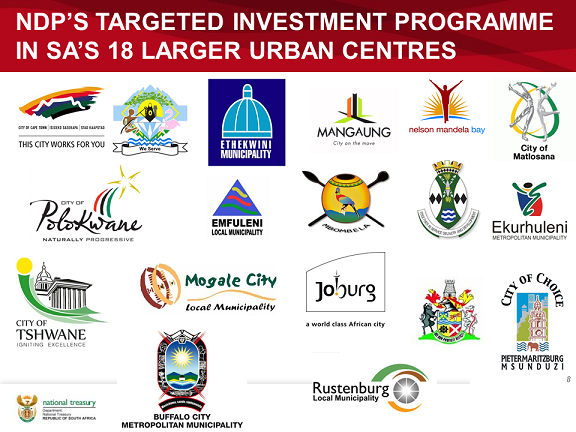NEIGHBOURHOOD DEVELOPMENT PROGRAMME
|
Page Content
|
URBAN NDP
Urban areas are the engine rooms of our economy. More than 60% of the country’s population depends on social and economic services located in the eight metropolitan centres. Our cities, however, face a number of challenges. The most obvious manifestation of urban challenges is evident in the spatial form of urban areas. Marginalised geographies such as townships and informal settlements are located far away from social and economic opportunities and amenities. People living in marginalised areas spend vast amounts of their disposable income and time on transportation between their homes and the better-located centres of opportunity. Such sprawling and highly segregated land-use patterns impose significant costs on poor households and the environment and divert public resources from poor to rich households (for example, through investments required to sustain existing urban infrastructure).
As such the implications for the new direction of the NDP Unit are the focus on the urban agenda and to support the spatial transformation of the urban form in SA’s larger 18 urban centres:
- To increase access to amenities, especially for the poor in marginalised settlement areas through the implementation of the Urban Network Strategy (UNS).
- To work towards a more efficient urban form that creates an environment that enables economic growth and development and catalyses private sector investment.
- To focuses on strategic spatial targeting that is aimed at creating a post-apartheid city-wide hierarchy of strategic nodes and the optimisation of public transport connectivity across all scales of the urban network, i.e. pedestrian, non-motorised and public transport movement to nodes, between nodes and within strategic nodes.
- To focus on spatial transformation through co-ordinating the implementation of a catalytic pipeline of projects, i.e. land development, housing, transport and infrastructure investments (and other interventions). The Urban Network Plan will be used to identify and plan urban hubs, central business districts, transport links and activity corridors to ensure greater co-ordination with other sector programmes; crowd-in investment, scale up impact and, over time, build a more spatially inclusive and efficient city.
- To include urban management for the targeted areas into the Urban Network model to ensure that such areas attract and retain investment and provides sustainable economic development services and facilities to local communities and especially the youth.
|
 |
Metros:
Buffalo City, City of Cape Town, City of Johannesburg, City of Tshwane, Ekurhuleni, Ethekwini, Mangaung, Nelson Mandela
Secondary Cities:
City Of Matlosana, Emalahleni / Witbank, Emfuleni, Mbombela, Mogale City, Msunduzi, Newcastle, Polokwane, Rustenburg, Sol Plaatje |
|
|
|
|